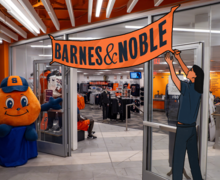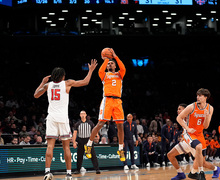Warming up: Winter Carnival committee strives to restore tradition to former glory
Danielle Matfess sat in the Winter Carnival planning meeting on an unusually warm Friday and glanced out the window into the glaring afternoon sun.
‘Let’s hope we get some snow in the next few days,’ she said.
The thaw, an unexpected 50-degree day following weeks of below-freezing temperatures, could threaten the upcoming week of snow events.
Matfess, a Syracuse University sophomore and co-chair of the Winterfest planning team, shared a dilemma countless SU alumni before her have faced: warm temperatures threatening the Winter Carnival. In its peak during the 1940s and 1950s, a pre-Winter Carnival thaw didn’t mean a sloppy snow sculpture contest or the canceling of a human dogsled race. It meant postponing the ‘best weekend of the year.’
Winter Carnival, formerly Winter Weekend, has characterized winter at SU since 1929. It’s taken different forms throughout the decades and seen varied turnouts and budgets. But the meaning behind it — a celebration of all things cold and wintry in a never-ending frosty February — remains the same.
Ron Harrington, from the Class of 1960, was the president of his senior class and of the Traditions Commission, which planned Winter Weekend.
‘Oh my gosh. Those weekends were a big deal,’ Harrington said from his home in Ventura, Calif. ‘It was the best weekend of the year and kind of a blowing off of steam after finals. You could either celebrate if you did well or commiserate with others if you didn’t get the best grades.’
At its prime from 1940-68, Winter Weekend meant a three- to five-day celebration comprising winter sport competitions at Drumlins, elaborate snow sculptures, the coronation of a snow empress and two dances. It caught national media attention and brought in musical acts, such as Sammy Davis Jr., Peter, Paul and Mary, and The Lovin’ Spoonfuls.
‘A couple of the winters, it seemed like the snow never melted. Into the spring, you were walking on sidewalks two or three or four feet higher than the concrete,’ Harrington said. Winter Carnival ‘was a rare chance to have some fun with it.’
Humble beginnings
In 1929, the Women’s Athletic Association teamed up with the SU Outing Club to hold a carnival the Saturday before exams, then held in February. A chartered bus took women for a day of skiing, toboggan races and dinner.
Three years later, then-junior Joe Aebischer expanded the event. He collected a $50 anonymous donation check and 50 cents from each fraternity and sorority to launch the first official coed Winter Carnival.
‘Economic times were tough,’ Aebischer wrote, looking back on his time at SU in a 1993 article in SU Orange Peel magazine. ‘The banks were still closed, money was scarce and campus fun was at a low ebb. But I knew snow was free and felt what Syracuse needed was a carnival.’
Aebischer organized the day of snow sports without a hitch, but when he went to Drumlins to talk to the owner about holding a dance, he got a resounding ‘no.’ The floors had recently been varnished and would not withstand shoe abrasion. So Aebischer vowed that every dancer would take his or her shoes off upon arrival. And there the Stockingfoot dance, a 38-year-old tradition, was born, and it evolved into a competition for the wackiest stockings.
‘Trying to find your shoes at the end of the evening made for a real mixer and many a campus romance began,’ Aebischer wrote.
Students stood in line for hours to buy tickets (55 cents for a couple in 1940). Senior Julie Anne Rempes wrote a reflection of her Winter Carnival experience in a Feb. 3, 1956, edition of The Daily Orange.
‘I remembered the lights, the noise, the socks, argyles, plaids, holes. Life passes. So do winter weekends. Back to the old grind, textbooks, work, thinking, the interlude was past.’
‘Snow fun like Winter Weekend’ The Daily Orange headline, Feb. 12, 1954
By the 1950s, the event had grown to one of the largest in the region. Snow sport competitions included Cornell University and Colgate University participants. The ice skating competition was so serious that some students complained when amateurs were allowed to skate.
Joanne Lafaro Moore, from the Class of 1955, judged the snow sculpture contest her senior year.
Originally limited to fraternity and sorority members, the competition opened up a second category for non-Greek entries in 1941.
‘It was the best part,’ said Moore, who celebrated her 55th college reunion in October 2010.
Moore remembers driving around with the judges, mostly art professors, and taking notes on the 71 entries that year. The theme was ‘Frozen Fables’ and was about characters or themes from fairy tales. Sculptures of the ugly duckling, Thumbelina and the many mythological dragons were all impressive enough to remain imprinted in Moore’s mind 52 years later.
Moore worked on her sorority, Theta Phi Alpha, sculpture all four years.
‘I can remember just rolling great big balls of snow to where the sculpture was going to be,’ she said. ‘We had the ideas, got the snow all together, and then the art students did the fine touches at the end.’
Moore, a piano major, doesn’t remember much of the formal Snow Ball from 1954. She had other things on her mind. Moore’s husband, Roger, graduated from Syracuse a year before her and joined the army. He left for Korea that winter, leaving her without a date to the dance.
‘He sent me a Christmas card that year,’ she said. ‘I think all he had was a crayon, but he used it to draw the most beautiful Korean landscape.’
As cold as she was in Syracuse that year, Moore said her thoughts were always with her husband in Korea.
‘It was very cold,’ she said, ‘and he was sleeping in a tent in the middle of winter.’
The carnival Moore knew in the 1950s continued to grow. In 1966, the university approved the largest budget ever granted to a university weekend: $26,000.
By 1968, when the student body became more politically involved with the war in Vietnam, snow sculptures were politicized. Theta Chi won the competition in 1968 for its ‘Johnson 1868 to Johnson 1968’ sculpture of President Lyndon Baines Johnson. A sign next to Johnson’s face read, ‘It’s still snowing,’ an intended critique of the president.
Modern meltdown
By the late 1960s, the weekend’s expansiveness had petered out as political activeness and a draft garnered most student attention. A revival in 2003 attempted to bring the weekend back but was ironically postponed because of too much snow. The rescheduled carnival attracted only four students for the wacky winter olympics, according to a story in The Post-Standard.
Since its revival in 2003, the Winter Carnival has become a different kind of celebration. The competitive skiing and ice skating has been replaced with more fun, carefree activities, such as human dogsled races, snow shoeing and chili cook-offs. Skating outside turned into skating indoors at the Tennity Ice Skating Pavilion. The snow sculpture contest that once boasted roof-high replicas of the Statue of Liberty and Crouse College now attract a much smaller group with far more modest creations.
In 2005 students turned out to break the record for the world’s largest snowball, but in 2006 only 13 people turned up to break the snow angel record (1,780 short of breaking that record).
But today’s 25-member Traditions Commission doesn’t see recent winter carnivals as a decline in spirit but as a different vocalization of school pride.
‘Today spirit is just expressed in a different way,’ said Courtney Jones, the Tradition Commission’s consultant and Student Life program coordinator. ‘And that’s reflective of the culture of campus and of America. Today it’s perfectly acceptable to make your Facebook status ‘Can’t wait for Winter Carnival.’ It’s different, but it doesn’t mean there’s less passion for the school.’
Jones hopes to see this year’s event bring the campus together.
‘It’s a large campus, and there are certain times when we all pull together — usually it’s for sports — but I hope Winter Weekend has that effect, so whether you talk to an alum of ‘56 or ‘78 or 2013, they all experienced Winter Carnival in some way, shape or form.’
Matfess, the current co-chair, ended the Winter Carnival meeting Friday by emphasizing the importance of using Twitter, Facebook and Foursquare to get the message out about this year’s events.
She’s excited about the coming week but said she can’t help feeling a bit envious of the Winter Weekends of days gone by.
‘I wish I was a student in 1950 all the time,’ Matfess said. ‘It’d be great to see it at its prime. But that’s kind of what we’re trying to do here by bringing Winter Carnival back to its roots. It’s still all about beating the winter blues.’
Published on February 21, 2011 at 12:00 pm





